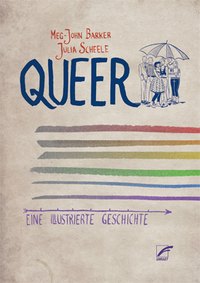Take a photo of a barcode or cover
1.06k reviews for:
Queer: Eine illustrierte Geschichte
Jennifer Sophia Theodor, Meg-John Barker, Julia Scheele
1.06k reviews for:
Queer: Eine illustrierte Geschichte
Jennifer Sophia Theodor, Meg-John Barker, Julia Scheele
I appreciate this book. As a younger queer, I learned a lot about history and terminology from it. It’s also what helped me finally understand pronouns!!! I’m a transmasc person who, at the time, struggled to understand how pronouns ≠ gender. THIS is the book that helped me understand it!
informative
reflective
slow-paced
challenging
informative
inspiring
reflective
slow-paced
Fascinating and accessible!
I loved this. I learned a lot, including some small awareness of how much I have to unlearn. As a largely visual thinker I found the illustrations extremely helpful. Recommended!
I loved this. I learned a lot, including some small awareness of how much I have to unlearn. As a largely visual thinker I found the illustrations extremely helpful. Recommended!
I'm super torn on this. I wanted it to be better.
First off, I misunderstood what this book was about. I expected a history book about queer activism told via comics, but it's actually an abbreviated illustrated text book about queer theory, which is a wholly different topic. It's still something that I was super interested in, but I was surprised and kinda curious about how they were gonna use comics to describe such abstract concepts.
And that's kinda where I think I stumbled with this one - the comics didn't really help as much as I thought they would. Each page would have a short paragraph of text (often explaining some pretty esoteric stuff) and then an illustrative comic to reinforce or further explain the point. But I really feel like some of these topics needed fewer drawings of the theorists heads and more actually explanation. The impression I get from a work like this is that its main purpose is to bring academic writing to a more user-friendly format to widen the access of people to the theories. But I don't think this book quite pulled it off. It was still pretty heady.
Honestly, the book might have been better if it was either longer or more narrowly focused. The topics were too condensed and I felt like not enough time was devoted to each topic. It think it went through way too much information without enough explanation, if its goal is indeed to bring academic theories to lay folk. And if that wasn't the point, I'm not sure who this book is for?
But man, I love the idea.
First off, I misunderstood what this book was about. I expected a history book about queer activism told via comics, but it's actually an abbreviated illustrated text book about queer theory, which is a wholly different topic. It's still something that I was super interested in, but I was surprised and kinda curious about how they were gonna use comics to describe such abstract concepts.
And that's kinda where I think I stumbled with this one - the comics didn't really help as much as I thought they would. Each page would have a short paragraph of text (often explaining some pretty esoteric stuff) and then an illustrative comic to reinforce or further explain the point. But I really feel like some of these topics needed fewer drawings of the theorists heads and more actually explanation. The impression I get from a work like this is that its main purpose is to bring academic writing to a more user-friendly format to widen the access of people to the theories. But I don't think this book quite pulled it off. It was still pretty heady.
Honestly, the book might have been better if it was either longer or more narrowly focused. The topics were too condensed and I felt like not enough time was devoted to each topic. It think it went through way too much information without enough explanation, if its goal is indeed to bring academic theories to lay folk. And if that wasn't the point, I'm not sure who this book is for?
But man, I love the idea.
As a queer person who, it turns out, doesn't know much about queer theory, this book is (I guess?) a nice intro to it. All the concepts felt quite accessible, and it's provided a few jumping-off points for me to explore further.
DNF at 25%. It would be challenging for this book to be more dull, which is disappointing, since the topic is so important.
hopeful
informative
fast-paced
informative
slow-paced
Great information. Poorly executed and slow 😴
informative
fast-paced
A graphic offering for competitive non fictional content can really open up thr subject matter for many people. The move to a graphic format seems to necessitate a shift towards bitesize and concise explanation and there are few things that benefit from this as much as academic theories do.
This book is about Queer Theory - it isn't to be mistaken for a history of Queer persons, which I don't think the cover really makes clear enough.
If you are interested in Queer Theory or you are struggling to understand it despite needing to for your studies, this book is a great place to start. I wish I'd had this as an undergraduate before trying to understand the complexities of Foucault - it would have truly helped. Not only because the book explains the basics of thinkers like Foucault, but places them in context and in chronological order with each other which is deeply helpful for overall understanding.
The basic and wide understanding that you can gain from this book gives you a great starting point to think more queerly, more rigorously and more purposefully about the content you engage with and the expectations, assumptions and normative society reinforces.
This book is about Queer Theory - it isn't to be mistaken for a history of Queer persons, which I don't think the cover really makes clear enough.
If you are interested in Queer Theory or you are struggling to understand it despite needing to for your studies, this book is a great place to start. I wish I'd had this as an undergraduate before trying to understand the complexities of Foucault - it would have truly helped. Not only because the book explains the basics of thinkers like Foucault, but places them in context and in chronological order with each other which is deeply helpful for overall understanding.
The basic and wide understanding that you can gain from this book gives you a great starting point to think more queerly, more rigorously and more purposefully about the content you engage with and the expectations, assumptions and normative society reinforces.





